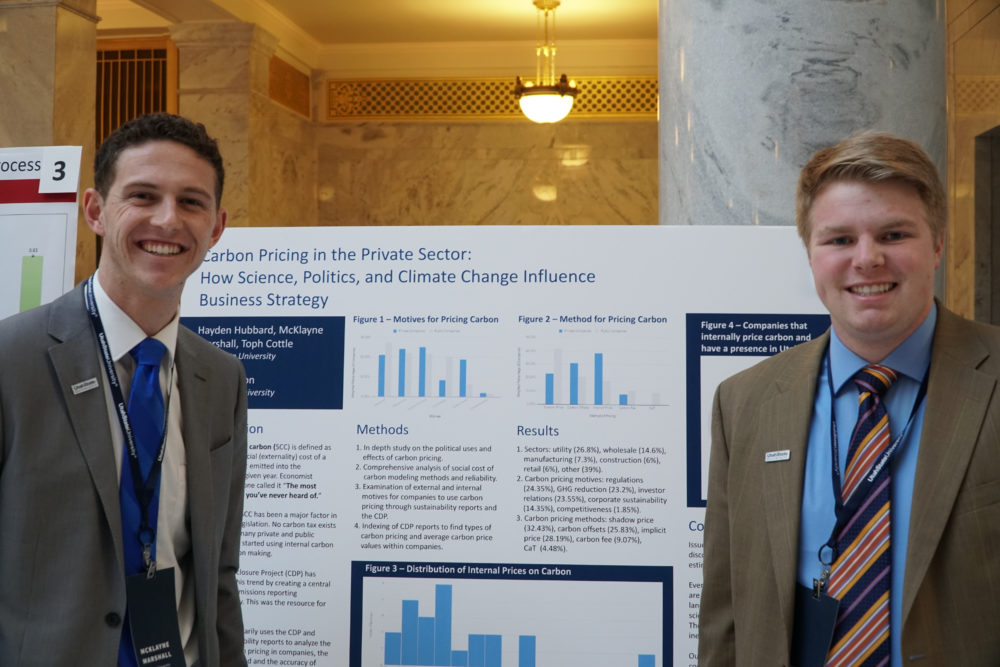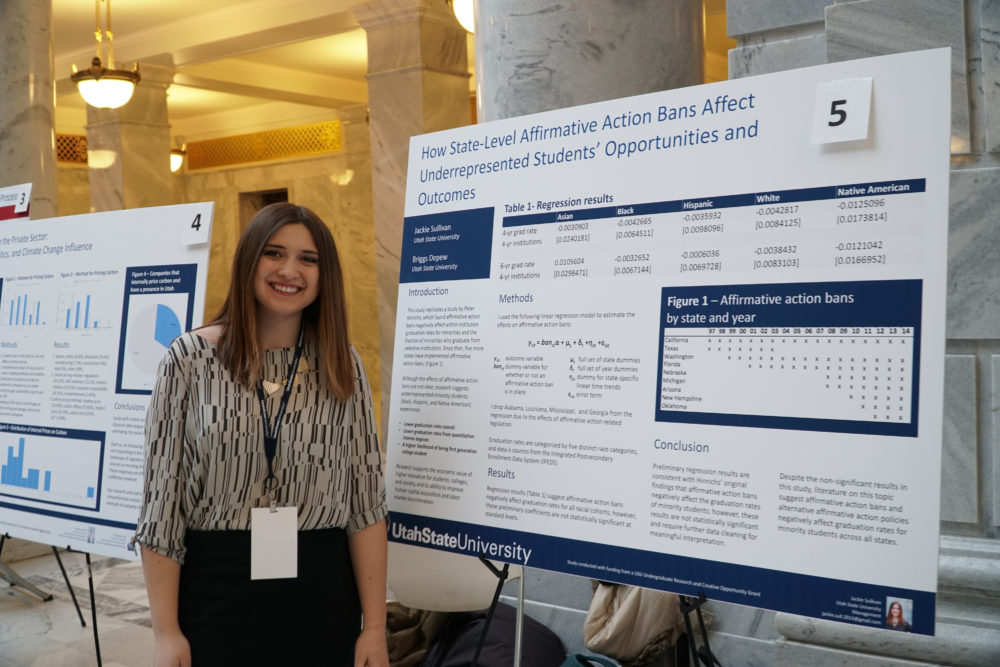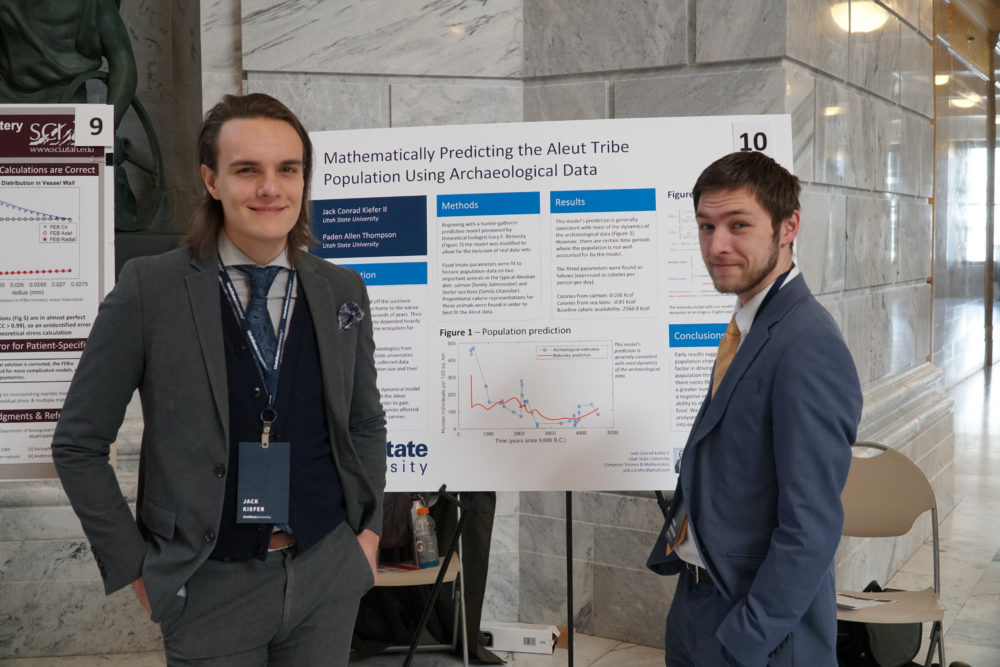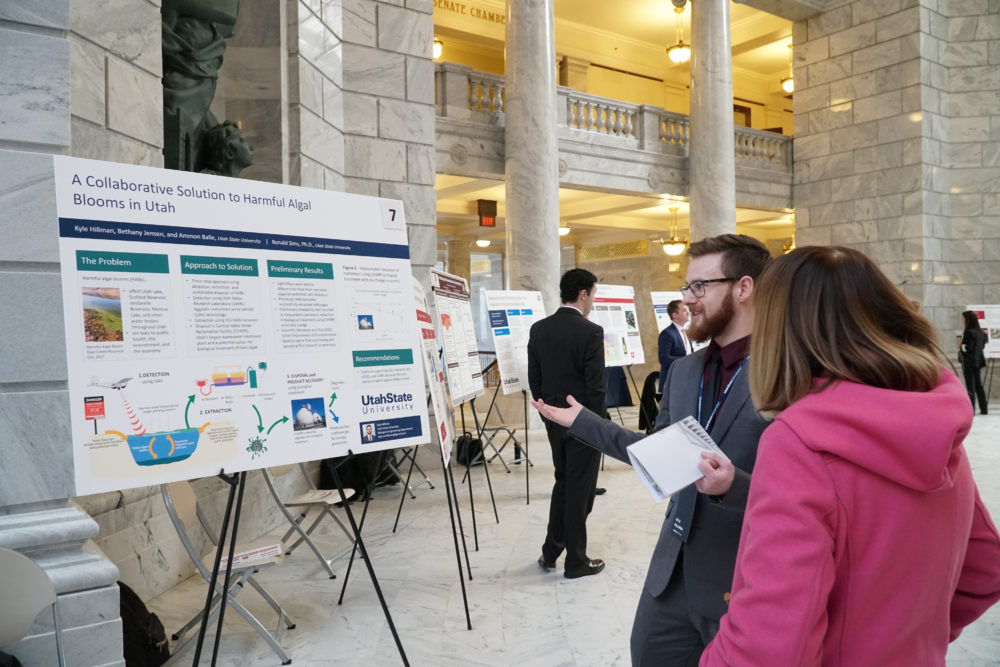Undergraduate research on Capitol Hill: Colleges of Business and Engineering
Editors note: This is part three of a three part series outlining the research undergraduate students took to Capitol Hill last February. Click here for parts one and two.
Utah State University’s Research Week gave students and faculty the opportunity to share and learn about the different research efforts being conducted on campus.
Hosted by the department of Research and Graduate Studies, Research Week held several events including the Faculty Author Exhibit, Ignite USU and the Student Research Symposium.
Last February, the RGS gave several undergraduate researchers the opportunity to take their projects to Capitol Hill in Salt Lake City. They presented on various topics from saving bees to helping children learn mathematics. In honor of Research Week, they have shared their projects with The Utah Statesman.
Jon M. Huntsman School of Business
McKlayne Marshall, Toph Cottle and Hayden Hubbard
 Tyler Grow
Tyler Grow McKlayne Marshall, Toph Cottle and Hayden Hubbard study business at Utah State. They want to know the social cost of carbon in the business sector and how science, politics and climate change influence business strategies.
Their main findings have been motives behind businesses adjusting their strategies due to climate change. Their main data source is the Carbon Disclosure Project. The group read through over 82 different company reports and indexed motives companies have for pricing carbon to understand this process.
“There is no uniformity of how businesses go about pricing carbon, which says a lot to people that are in business because if that market cannot figure out a general way of doing things, then there needs to be some uniformity in that,” Marshall said.
The group has found there are three main things as far as methodology for pricing carbon. One is a shadow price, a number that they make up or calculate on their own for the risk of regulation. Two is implicit price, when they use a price that has been made by the government to charge or use as a shadow price. Three is a Carbon tax or fee, that is when they directly charge themselves and invest into renewable energies.
“This research will help business run their carbon resources better,” Cottle said.
Jackie Sullivan
 Tyler Grow
Tyler Grow Jackie Sullivan is studying economics and finance at Utah State. She wants to know how affirmative action bans presently affect racial minorities.
Affirmative action is a policy that favors those who suffer from discrimination, and Sullivan focused on the relation to higher education enrollment.
“There was a project done a few years ago on the effects of affirmative action bans on enrollment in higher education for minority students,” Sullivan said. “Since then, there have been a few more states and a few more years of data, and so I wanted to replicate it and see if what he found still holds.”
She focused on the background, methodology and preliminary stats that she had gathered.
Sullivan found affirmative action bans decrease college enrollments for certain racial minorities and decrease college enrollments for other racial minorities.
“The complicated issue is that there are a lot of theories about why that happened. But what I think that the methodology behind it is really cool,” Sullivan said.
In observational studies, making clean observations is difficult due to confounding factors, such as financial status. Sullivan explained that, in this experiment, this setup works is because there are specific states that will ban affirmative action, but neighboring states won’t. So, they can take similar student populations and see the difference over time.
College of Engineering
Jack Keifer and Paden Thompson
 Tyler Grow
Tyler Grow Jack Keifer and Paden Thompson are studying computer science at Utah State. They want to know how a hunter-gatherer interaction in a habitat effects its resources.
By creating a theoretical framework, the team has found a way to model hunter-gatherer population dynamics and the interaction of these two forces. But for a well-rounded project, Keifer and Thompson decided to also look at empirical archaeological evidence that also provided them with ideas of how historically hunter-gatherers have interacted.
“We marry these two methods by augmenting an existing mathematical model to incorporate archaeological data on the historic interactions between the native Aleut peoples and the Sanak Island marine ecosystem,” Keifer said.
The team predicts how the paleo-ecology of regions works. This offers a new perspective for research in different societies that use the hunter-gatherer model.
The team has also created a model that can predict hunter-gatherer population changes with archaeological findings. This serves to model the historic Aleut population in the southern Alaskan peninsula.
“In an ironic there exists the theoretical possibility that the number of sea lions and salmon, two of the Aleuts’ most common prey, in the area at the time had an inverse effect on the Aleuts’ ability to obtain sufficient calories to feed everyone,” Keifer said. “As we are mathematicians and not really ecologists, we can only speculate as to why such a thing might have occurred.”
Kyle Hillman
 Tyler Grow
Tyler Grow Kyle Hillman is studying engineering at Utah State. He wants to find a solution to harmful algae blooms in Utah, which are getting worse and worse each growing season.
The harmful blooms are caused by years and years of nutrient pollution water treatment plants and agricultural runoff. There are no nutrient limits on outputs or inputs at this point in Utah. Climate change due to longer growing seasons has created a situation where many harmful microorganisms in the water grow and thrive.
The microorganisms are harmful to people, animals, businesses and other water sources.
“The only current solution is to post signs for people to not recreate. It is not sustainable, and it not really solving the problem, it is only mitigating risk,” Hillman said.
Hillman’s project is a three-step approach to harmful algae blooms in Utah. The first step is detection using Utah Water Research Laboratory’s air technology. Unmanned aerial vehicles fly around and find these blooms by finding blue-green algae with light filters.
The second step is to harvest the algae using a continuous flow, no chemicals added approach. A harvester, designed by students at Utah State, is used to harvest the algae.
The third step is sustainable disposal. Biological treatment is used to degrade the toxic algae and turn it into biomethane gas for energy generation.
“It is turning this public health liability into a valuable product,” Hillman said. He plans to continue his research next fall.
To view each undergraduate’s abstract look here.
— shelby.black@aggiemail.usu.edu
@shelbsterblack
—brianne.sorensen@aggiemail.usu.edu
@SorensenBrianne

